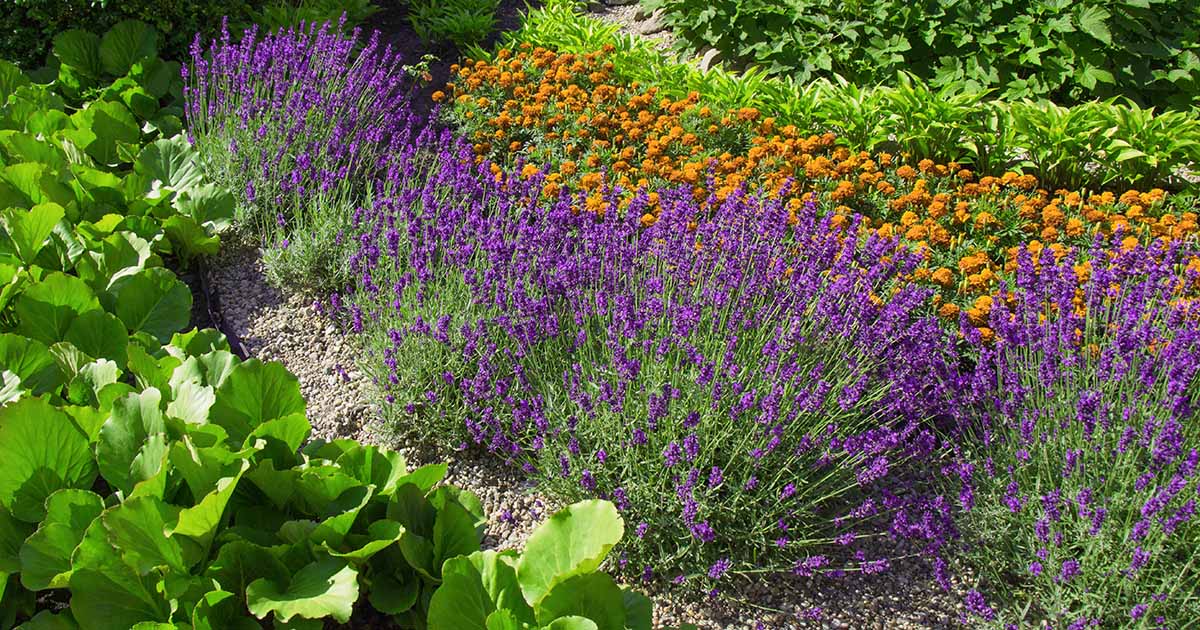Also known as lily of the Nile, spring- to summer-blooming agapanthus has mounds of strappy basal foliage, erect, leafless flower stalks, and mature dimensions of 22 to 44 inches tall and wide.
It’s an aggressive grower that requires dividing every four to five years, and like lavender, prefers a snug-fitting pot when grown in a container.


Purple Agapanthus
Agapanthus attracts bees and butterflies, contributing to biodiversity in the home landscape and surrounding area.
Purple agapanthus rhizomes in packages of three, six, and nine are available from Eden Brothers.
See our guide to growing agapanthus for cultivation details.
2. Anise Hyssop
Edible anise hyssop, Agastache foeniculum, is a short-lived mid- to late summer flowering perennial for Zones 4 to 9 that completes its life cycle in about three years. In ideal conditions it spreads via rhizomes and self-seeding.
Plants attract pollinators with upright spikes of unscented tubular blossom clusters in shades of blue, lavender, or purple. The scalloped foliage is sweetly aromatic with hints of anise and licorice.
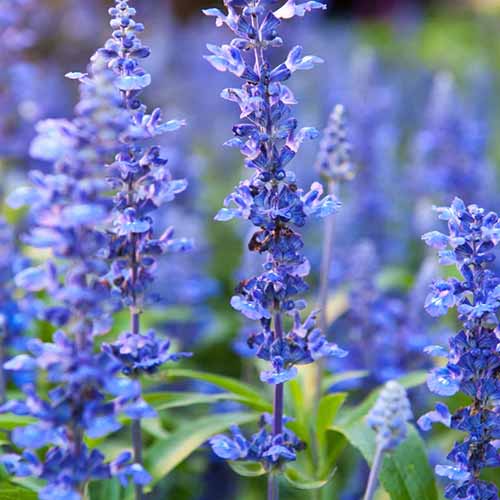

Violet-Blue Anise Hyssop
Grow in full sun to part shade with average soil and low to moderate moisture. Fast-growing anise hyssop achieves mature dimensions of 24 to 48 inches tall and 18 to 36 inches wide.
Violet-blue anise hyssop seeds are available from Eden Brothers in one-ounce, quarter-pound, and one-pound packages.
See our guide to growing anise hyssop for more information.
3. Beardtongue
Beardtongue, Penstemon spp., aka penstemon, is a summer-blooming perennial for Zones 3 to 9.
It’s a pollinator favorite, with tall stalks bearing clusters of downward-facing, tubular blossoms, and comes in a rainbow of colors as well as bicolor combinations.
Plants grow in full sun to part shade with sandy, fertile soil and low moisture. Mature dimensions vary from six to 60 inches tall and 12 to 36 inches wide, depending on the type.
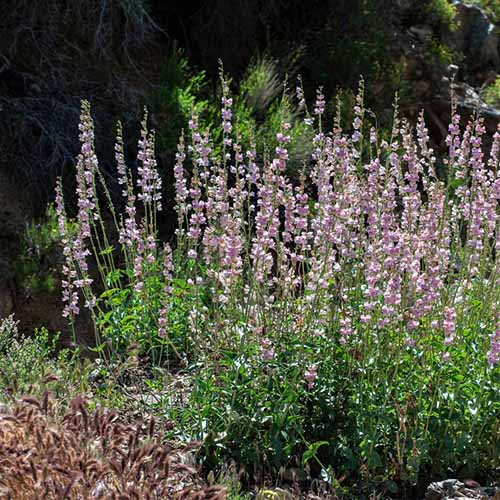

Palmer’s Beardtongue
Palmer’s beardtongue, Penstemon palmeri, is a fragrant species with pink flowers and stems up to 48 inches tall, providing a stunning backdrop in beds and borders.
Palmer’s beardtongue seeds are available from Eden Brothers in packet and one-ounce packages.
Our guide to growing beardtongue has cultivation details.
4. Black-Eyed Susan
Black-eyed Susan, Rudbeckia hirta, is a short-lived flowering perennial for Zones 3 to 9, yielding three to five years of abundant blooms. Many gardeners grow it as an annual.
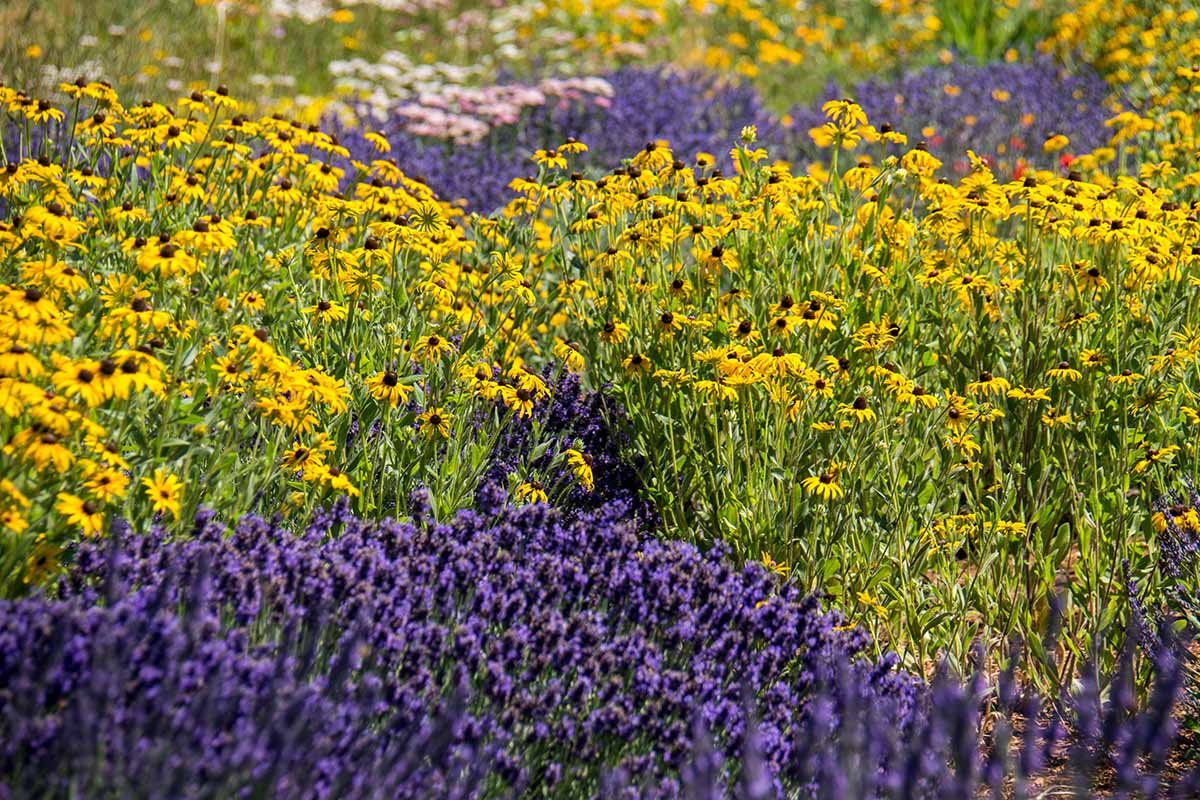

The orange-yellow, daisy-like blooms and brown centers are iconic summer-to-fall flowers that appeal to pollinators.
Black-eyed Susans thrive in full sun with organically-rich soil.
They grow fast and have low to moderate water needs once established, making them ideal as a companion for lavender.
Mature dimensions are 24 to 36 inches tall and 12 to 18 inches wide.
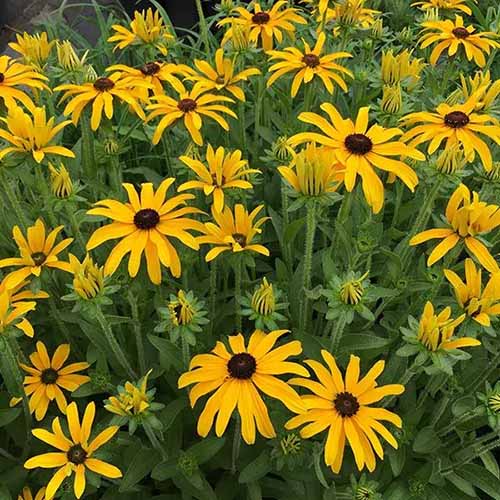

Rudbeckia x ‘Glitters Like Gold’
Rudbeckia x ‘Glitters Like Gold’ is a prolific hybrid cultivar with exceptional heat tolerance.
‘Glitters Like Gold’ black-eyed Susan plants are available from Nature Hills Nursery in #1 containers.
Our black-eyed Susan growing guide has more information.
5. Boxwood
Boxwood, Buxus spp., is a woody shrub for Zones 4 to 9 that prefers full sun to part shade, average to fertile soil, and moderate moisture.
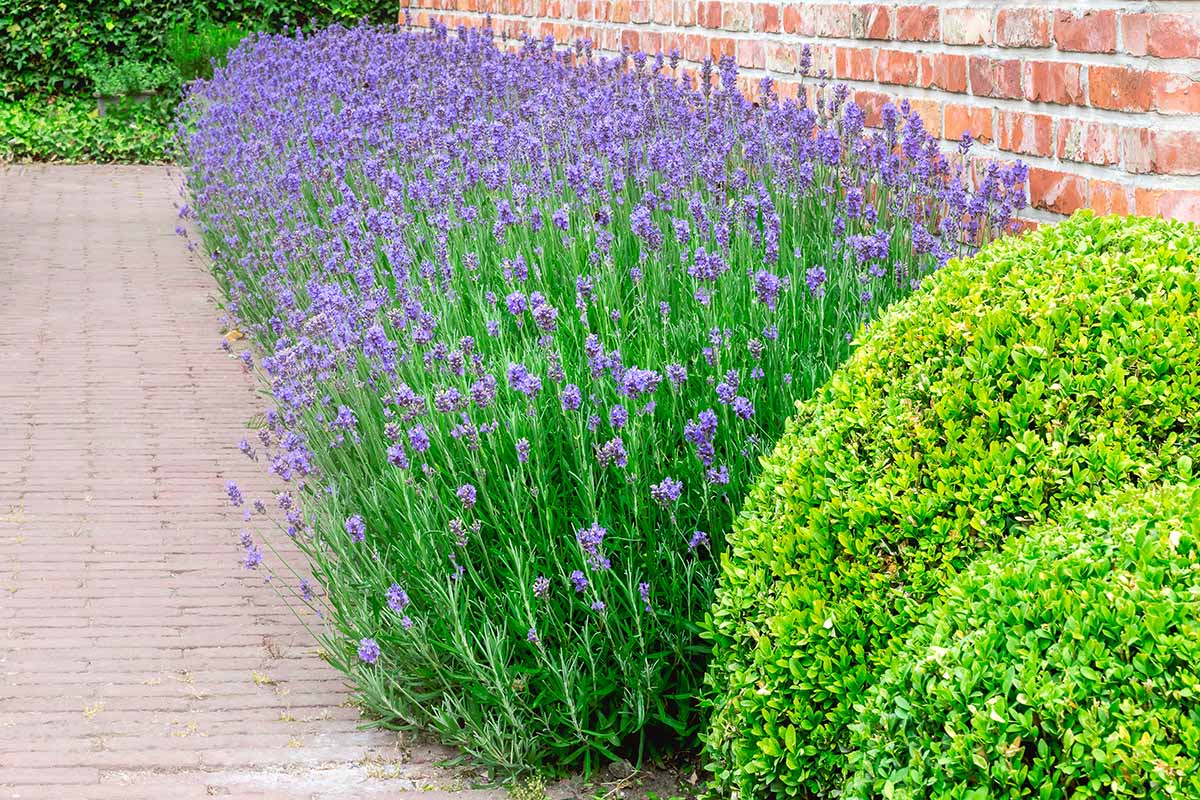

Mature dimensions are five to 15 feet tall and wide.
The glossy, rounded, evergreen foliage is easy to prune into topiaries or hedges for formal garden design schemes.
Nondescript greenish flowers appear in spring followed by seeds that attract feeding birds.
‘Green Gem’ boxwood is a compact, winter-hardy hybrid cultivar that prefers full sun and has mature dimensions of two to three feet tall and wide.


‘Green Gem’ Boxwood
‘Green Gem’ boxwood shrubs are available from Nature Hills Nursery in #1 and #5 containers.
Learn more about boxwood cultivation in our guide.
6. Coneflower
The daisy-like coneflower, Echinacea spp., is a mid- to late summer blooming perennial for Zones 5 to 9 with edible flowers in orange, pink, purple, red, white, or yellow.
It grows in full sun to part shade locations with sandy loam and low moisture.
Depending upon the type, heights can reach up to 48 inches with a spread of up to 18 inches.
Coneflower is a pollinator magnet that attracts bees, beneficial insects, and butterflies to its nectar, and songbirds to the seed-laden cones at season’s end.
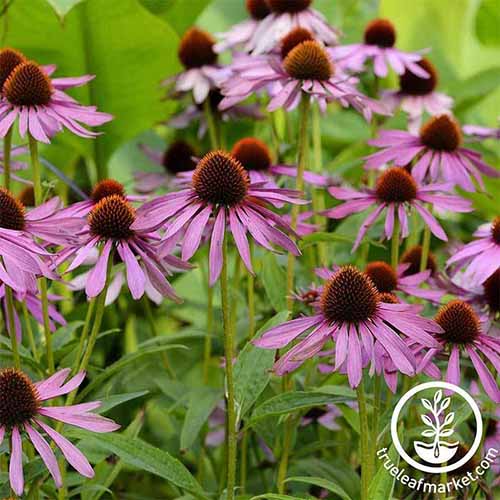

Purple Coneflower
Plants have an exceptional tolerance for drought, heat, and poor soil. Deadheading encourages optimal blooming.
Purple coneflower seeds are available from True Leaf Market in one-gram, one-ounce, four-ounce, and one-pound packages.
Read more in our coneflower growing guide.
7. Coreopsis
Aster-like Coreopsis spp., aka tickseed, is an early summer flowering perennial for Zones 4 to 10 that can be grown as an annual elsewhere, with cream, pink, red, or yellow jagged-edged flowers atop wiry, leafless stems.
Plants thrive in full sun with lean soil and moderate water. Mature dimensions are one to three feet tall with an equal spread.
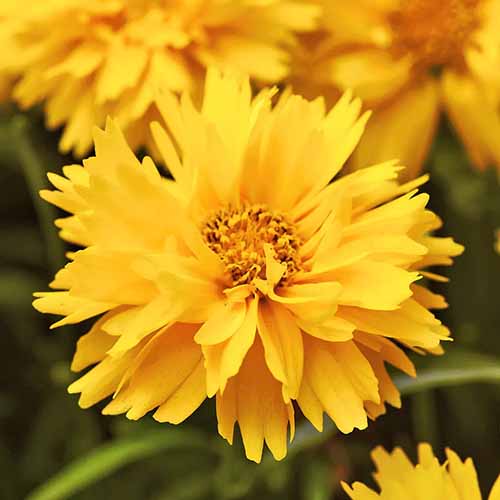

‘Double the Sun’ Cosmos
Drought- and heat-tolerant Coreopsis grandiflora ‘Double the Sun’ boasts bright yellow semi-double blooms and a compact 12 to 14-inch form for a striking contrast to spikes of lavender.
‘Double the Sun’ coreopsis seeds are available from Burpee in packages of 150.
Learn more about growing coreopsis in our guide.
8. Creeping Juniper
Creeping juniper, Juniperus horizontalis, is a low-profile, low-maintenance perennial woody evergreen for Zones 4 to 9. Mature dimensions are up to two feet tall with a spread of up to 10 feet.
Depending on the type, the foliage may be blue, green, or purple. Blue cones or berries may be produced when a male and female plant are growing in the vicinity of one another.
Creeping juniper thrives in full sun to part shade with well-draining sand, loam, or clay soil and moderate moisture. They offer a rich textural counterpoint to lavender.
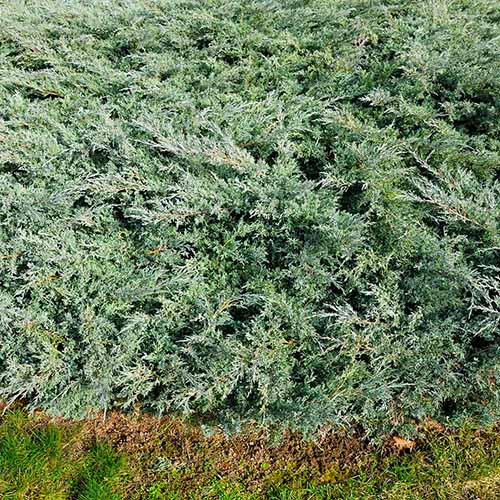

‘Wiltonii’ Creeping Juniper
Wiltonii’ is a cultivated variety that matures to a height of 12 inches with a spread of five to six feet.
‘Wiltoni’ juniper plants are available from Fast Growing Trees in one- and three-gallon containers.
Read our guide to growing creeping juniper for further information.
9. Daylily
The star-shaped perennial daylily, Hemerocallis spp., grows in full sun to part shade in Zones 3 to 9.
Extensive hybridization has produced a varied color palette, including orange, pink, red, and yellow. Heights range from one to six feet with a spread of two to four feet.
A very accommodating summer bloomer, the daylily tolerates some shade but produces fewer blooms without full sun. It thrives in organically rich, moist soil but tolerates some drought and oversaturation.
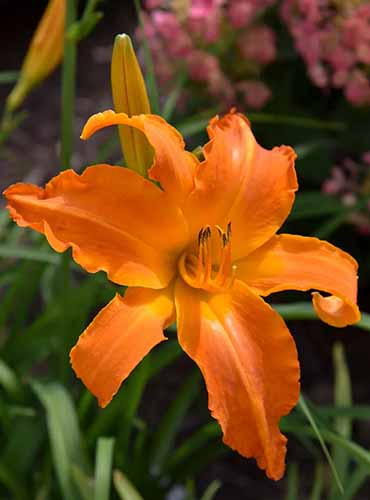

‘Primal Scream’ Daylily
‘Primal Scream’ is a cultivar that sports bright tangerine-orange blossoms with a golden shimmer that sway atop 34-inch stems for a dramatic contrast to lavender.
Expect a spread of 18 to 24 inches.
You can find ‘Primal Scream’ available from Burpee in single bare root packages.
Learn more about daylily cultivation in our guide.
10. Ice Plant
The ice plant, Delosperma cooperi, is a succulent, ground-covering perennial for Zones 6 to 10. Mature dimensions are 4 to 6 inches tall and 12 to 24 inches wide.
Cultural requirements include full sun, lean, gritty soil, and low moisture.
The foliage is needle-like and evergreen. Aster-like orange, pink, purple, red, or yellow flowers bloom from summer to fall.
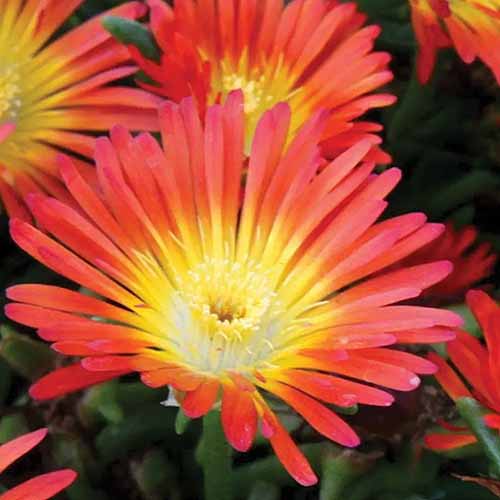

Delosperma cooperi ‘Fire Wonder’
‘Fire Wonder’ has vibrant red petals with yellow centers for a bold splash of color in mixed groupings underneath and around your lavender shrubs.
Mature heights are six to eight inches with a 20- to 24-inch spread.
You can find ‘Fire Wonder’ plants available from Burpee.
11. Marigold
The edible dwarf French marigold, Tagetes patula, is a summer annual for Zones 2 to 11 that prefers full sun, fertile soil, and medium moisture.
Mature heights are six to 12 inches with a spread of six to nine inches.
Cultivars are available in shades of orange, red, yellow, and bicolor combinations and may have one or more rows of petals surrounding a prominent center crest.
Their petite stature makes them well-suited to grow as ground cover around lavender.
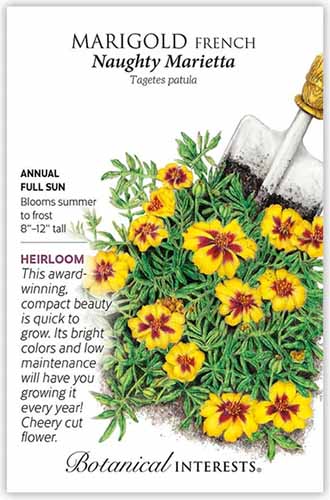

‘Naughty Marietta’ French Marigold
‘Naughty Marietta’ has bright yellow petals, maroon centers, and mature heights of eight to 10 inches with an equal spread. It blooms from summer to fall.
Naughty Marietta seeds are available from Botanical Interests in packages of approximately 140 seeds.
You can learn more about French marigolds in our guide.
12. Portulaca
Summer-flowering portulaca, Portulaca grandiflora, aka moss rose, is a low-profile perennial succulent with bright, rose-like single- or double-petaled flowers in orange, pink, red, white, and yellow hues.
It’s hardy in Zones 10 to 12 and can be grown as an annual in other regions.
Plants thrive in full sun with lean to fertile, gritty soil, and low water. Mature dimensions are up to nine inches tall with a spread of eight to 20 inches, depending on the cultivar.
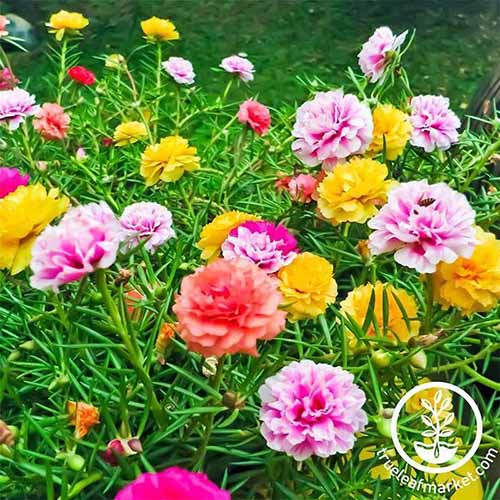

Double Mix Portulaca
Double Mix is a blend that provides a rich color palette, including canary, carmine, fuchsia, ivory, and peach flowers. Plants may self-seed in ideal conditions.
You can find seeds available from True Leaf Market in a variety of packet sizes.
Discover more about portulaca in our growing guide.
13. Red Hot Poker
Perennial red hot poker, Kniphofia spp., aka torch lily, has upright spikes of downward-facing, tubular, bright orange and yellow flowers.
It is suited to cultivation in Zones 5 to 9 and blooms from spring through summer.
Plants prefer full sun, sandy loam, and moderate water. Mature dimensions are 12 to 72 inches tall and 12 to 36 inches wide.
Drought-tolerant ‘Redhot Popsicle’ is a cultivar with mature dimensions of 15 to 18 inches tall and 18 inches wide.


Kniphofia ‘Redhot Popsicle’
It is a modestly proportioned garden pal for your lavender that attracts butterflies and hummingbirds.
‘Redhot Popsicle’ plants are available from Nature Hills Nursery in #1 containers.
14. Red Valerian
Red valerian, Centranthus ruber, aka Jupiter’s beard, is a perennial for Zones 4 to 9 that produces multiple clusters of star-shaped, tubular pink, red, or white summer to fall blossoms favored by hummingbirds and other pollinators.
Some gardeners find the fragrance sweet while others describe it as unpleasant so you may wish to plant it out in a meadow instead of beneath a kitchen window.
The woody stems reach mature heights of 24 to 36 inches with a spread of 12 to 24 inches. Plants prefer full sun, average soil, and medium moisture.
They tolerate drought well and may fail to thrive in humid regions.
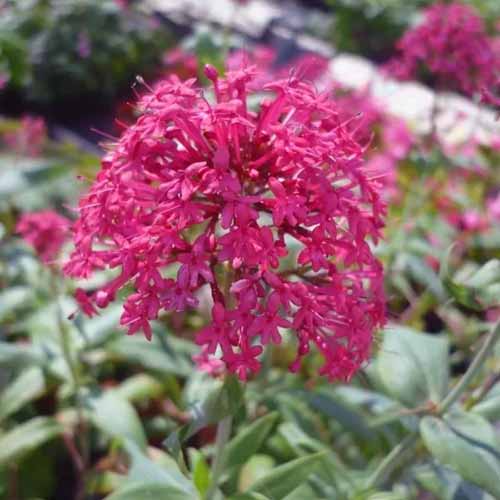

‘Coccineus’ Red Valerian
Centranthus ruber ‘Coccineus’ has fragrant magenta-red flowers and mature dimensions of 24 to 36 inches tall and wide, making a bold statement when planted with lavender.
‘Coccineus’ red valerian is available from Nature Hills Nursery.
15. Rosemary
Rosemary, Salvia rosmarinus syn.Rosmarinus officinalis is an edible perennial subshrub suited to cultivation in Zones 8 to 10, with some cultivars hardy to Zone 6.
Cultural requirements include full sun, average soil, and low to moderate moisture. Mature dimensions are four to six feet tall with a six- to eight-foot spread.
The aromatic, savory, needle-like foliage of rosemary is accented by spikes of tiny blossoms in shades of blue, pink, or white from late winter to late spring and sometimes again in late summer.


Rosemary
Drought-tolerant rosemary requires minimal water once established and is well-suited to xeriscaping.
You can find packets of rosemary seeds available from Eden Brothers.
See our rosemary growing guide for more information.
16. Salvia
Salvia, Salvia spp. is a hardy perennial for Zones 3 to 10 with spikes of tiny blue, orange, pink, purple, red, yellow, or white flowers from spring to fall that are very attractive to pollinators.
Cultural requirements include full sun to part shade, sandy loam, and low to moderate moisture.
Mature dimensions are one to five feet tall and two to four feet wide. The spiked form complements that of lavender, and you can increase the visual value by mixing colors.


Salvia ‘Flare’
‘Flare’ boasts bright red blossoms, prefers full sun, and reaches mature dimensions of 18 to 20 inches tall with a spread of 12 to 16 inches, for a compact garden companion.
‘Flare’ seeds are available from Burpee in packages of 75.
Learn more about growing salvia in our guide.
17. Sedum
Sedum, Sedum spp., aka stonecrop, is a genus of succulent annuals, biennials, and perennials with fleshy foliage and typically star-like flowers. There are varieties for Zones 3 to 10.
These summer-to-fall bloomers prefer full sun to part shade, lean, gritty soil, and low to moderate moisture.
Depending on the type, they mature to heights of three to 24 inches with a spread of 24 to 36 inches. From ground covers to upright plants, options suit various garden settings.
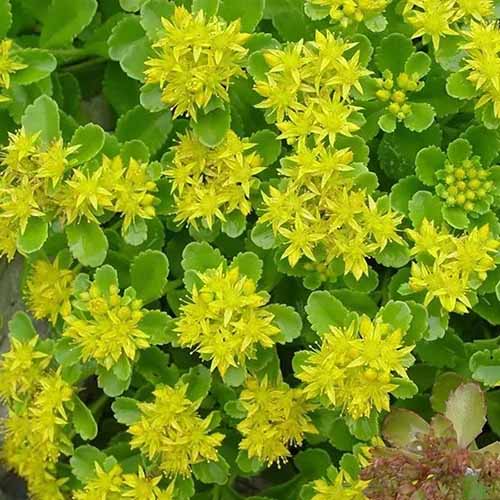

Sedum ‘Lemon Drop’
‘Lemon Drop’ is a striking ground cover variety with scalloped foliage and clusters of bright yellow, starry flowers.
The species is suitable for Zones 4 to 9 and matures to six inches tall and eight to 12 inches wide, making a pretty accent when grown with lavender.
‘Lemon Drop’ plants are available from Nature Hills Nursery in #1 containers.
Learn more about how to grow stonecrop in our guide.
18. Small Globe Thistle
The spiky, lavender blue, ball-like flowers of small globe thistle, Echinops ritro, add movement and texture to the garden as they jiggle in the breeze from mid to late summer.
Suited to Zones 3 to 8, they prefer full sun, average to lean soil, and low moisture.
Mature heights are 36 to 48 inches tall with a spread of 24 to 30 inches. With its complementary color and whimsical shape, small globe thistle makes a striking lavender companion.


Small Globe Thistle
As a low-water, low-maintenance species, Echinops ritro is especially suited to xeriscaping.
Small globe thistle seeds are available via Amazon in packages of 25.
You can learn more about small globe thistle cultivation in our guide.
19. Yarrow
Yarrow, Achillea spp., is a water-wise semi-evergreen perennial for Zones 3 to 9 with flattened flower heads consisting of masses of tiny pink, red, white, or yellow blossoms.
It flowers in late spring through summer and prefers full sun, lean, loose soil, and low water.
Plants have exceptional heat and drought tolerance. Mature heights are two to four feet with a spread of one to three feet.
The flattened form adds dimension and texture to gardens containing spikes and daisy heads.
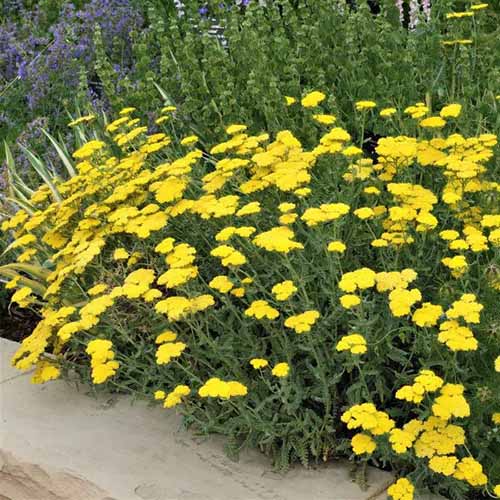

‘Moonshine’ Yarrow
‘Moonshine’ is a neon yellow hybrid that pops like sunshine in the garden, especially when paired with purple spikes of lavender.
Mature dimensions are a compact 18 to 24 inches tall and wide, making it a uniform, well-behaved neighbor.
‘Moonshine’ yarrow is available from Nature Hills Nursery in #2 containers.
You’ll find more information about growing yarrow in our guide.
Lovely Lavender and Friends
With 19 companions for lavender, it’s time to take out the garden planner and decide how to incorporate your favorites into an existing or entirely new design.
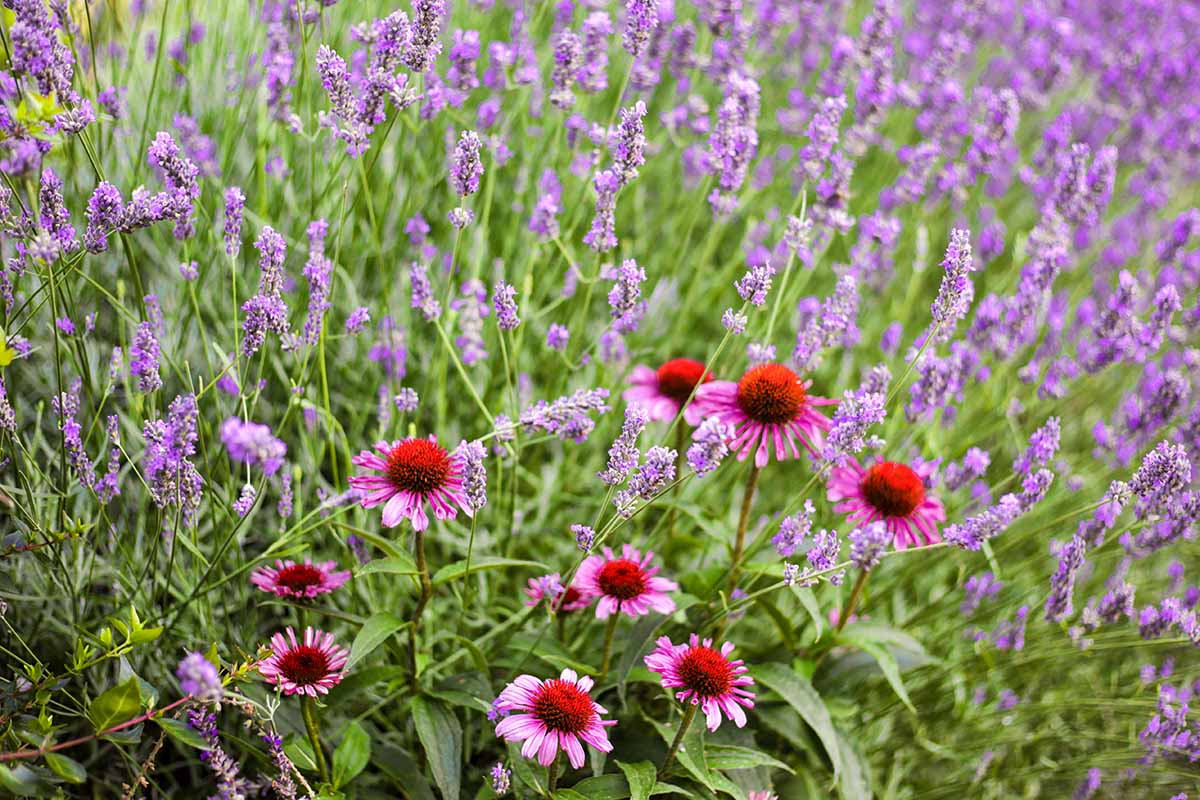

Consider features like form, texture, and color to vary your garden scheme. With plants in hand, move them around and decide how to group them before unpotting and planting.
Vary the heights to add depth and repeat a color or species at regular intervals to unify the arrangement.
What companions do you grow with your lavender? Tell us in the comments below.
If you found this article informative and want to learn more about lavender cultivation, we recommend the following:

